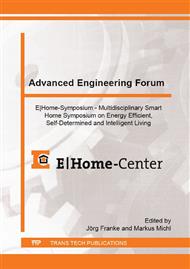[1]
Klemeš, Jiří Jaromír; Handbook of process integration (PI) - minimisation of energy and water use, waste and emissions. Woodhead Pub., Cambridge, U.K. (2013).
Google Scholar
[2]
Kemp, Ian C.; Pinch Analysis and Process Integration (2nd Edition) - A User Guide on Process Integration for the Efficient Use of Energy. Butterworth-Heinemann, Oxford, UK (2007).
Google Scholar
[3]
Linnhoff, B. ; Flower, J. R.; Synthesis of heat exchanger networks: Part I: Systematic generation of energy optimal networks. AIChE Journal 24 (1978), S. 633-642.
DOI: 10.1002/aic.690240411
Google Scholar
[4]
Krummenacher, Pierre; Contribution to the Heat Integration of Batch Processes (with or without Heat Storage). an der École polytechnique fédérale de Lausanne (2001).
Google Scholar
[5]
Kemp, I. C.; Deakin, A. W.; The Cascade Analysis for Energy an Process Integration of Batch Processes - Part 1 Calculation of Energy Targets. Chemical Engineering Research & Design 67 (1989), S. 495-509.
Google Scholar
[6]
DIN EN 13203-2: Gas-fired domestic appliances producing hot water - Part 2: Assessment of energy consumption (German version). (2015).
DOI: 10.3403/30142871u
Google Scholar
[7]
DIN V 4701-10 Energy efficiency of heating and ventilation systems in buildings - Part 10: Heating, domestic hot water supply, ventilation. (2003).
Google Scholar
[8]
Commision Regulation (EU) No 1015/2010 - Implementing Directive 2009/125/EC of the European Parliament and of the Council with regard to ecodesign requirements for household washing machines. Official Journal of the European Union (2010).
Google Scholar
[9]
Commision Regulation (EU) No 1016/2010 - Implementing Directive 2009/125/EC of the European Parliament and of the Council with regard to ecodesign requirements for household dishwashers. Official Journal of the European Union (2010).
Google Scholar
[10]
Borges, Bruno N; Hermes, Christian JL; Gonçalves, Joaquim M; Melo, Cláudio; Transient simulation of household refrigerators: a semi-empirical quasi-steady approach. Applied Energy 88 (2011), S. 748-754.
DOI: 10.1016/j.apenergy.2010.09.019
Google Scholar
[11]
Commission Delegated Regulation (EU) No 1060/2010 - Energy labelling of household refrigerating appliances. Official Journal of the European Union (2010).
Google Scholar
[12]
Commission Regulation 643/2009 - Ecodesign requirements for household refrigerating appliances. Official Journal of the European Union (2009).
Google Scholar


